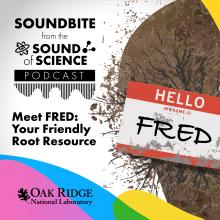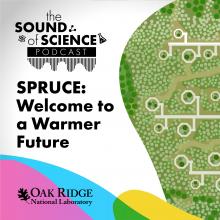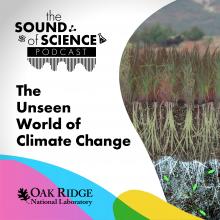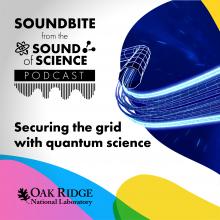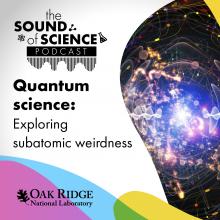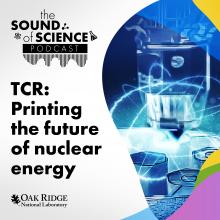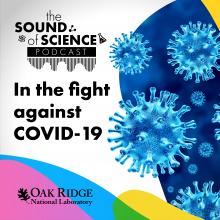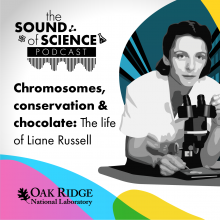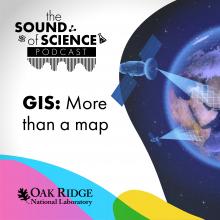Menu
The Sound of Science
A podcast that lets you hear the voices behind the scientific breakthroughs at Oak Ridge National Laboratory.
Listen on Apple Podcasts or use this RSS feed to add a new subscription in any podcast player.
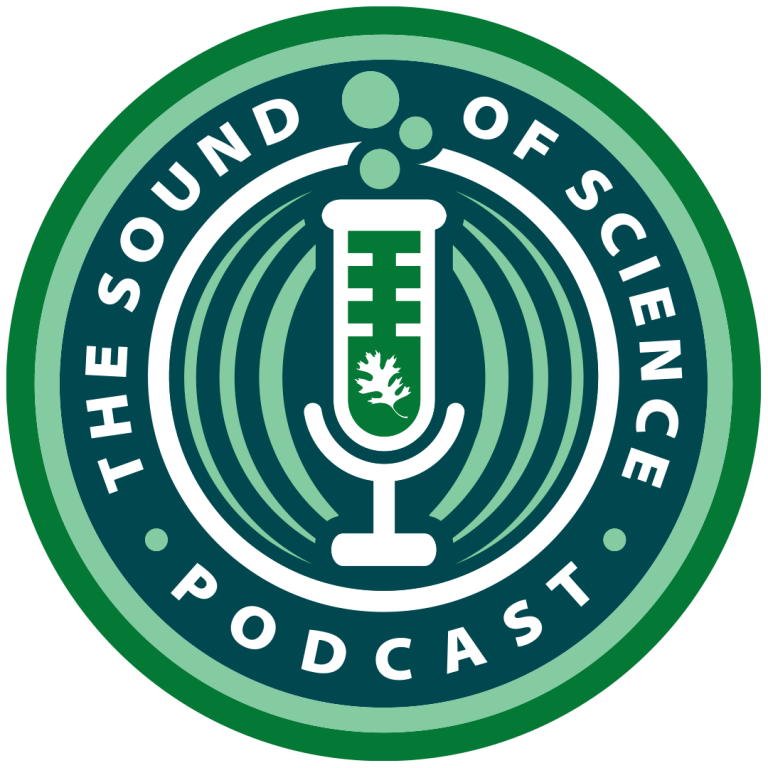
Soundbite: Meet FRED — Your Friendly Root Resource
Soundbite: Have you met FRED? The Fine Root Ecology Database — also known as FRED — is a collection of root trait data from research performed around the world. Roots play an important role in all ecosystems, but are often overlooked by computer models. The data in FRED can help computer modelers more accurately predict climate change scenarios. In this shorter installment of "The Sound of Science" podcast series, you'll hear from ORNL scientist and root aficionado Colleen Iversen, who leads the effort to collect data for FRED.
SPRUCE: Welcome to a Warmer Future
Deep in the forests of northern Minnesota, lies something that looks a little out-of-this-world. Long boardwalks connect a series of octagonal pods that serve as gateways into the future. But this isn’t some secret alien colony. It’s a large-scale research project that’s studying the effects of climate change on the peatland ecosystem. The project is called the Spruce and Peatland Responses Under Changing Environments experiment, or SPRUCE. The goal of the project is to understand how climate change impact this delicate landscape. In this episode, you'll hear from members of the SPRUCE team about what they've learned from the experiment so far.
The Unseen World of Climate Change
The Arctic tundra of Alaska features a picturesque landscape, teeming with plants and wildlife. But below ground lies a significant threat to the environment. As temperatures rise around the globe, layers of soil known as permafrost, which have been frozen for up to thousands of years, are beginning to thaw. And with that, threatening to release massive amounts of trapped greenhouse gases into the atmosphere. To study these dramatic changes, the U.S. Department of Energy launched the Next-Generation Ecosystem Experiments, or NGEE Arctic, project. NGEE brings together an interdisciplinary team to study the complex scientific processes that occur as the permafrost starts to thaw. In this episode, you'll hear members of the team discuss their research, what it's like to work in the Arctic tundra - including a wildlife story or two.
Soundbite: Quantum security for the grid
Soundbite of "The Sound of Science": In the last episode, we discussed the strange world of quantum mechanics. The laws of quantum mechanics describe the odd behavior of subatomic particles. Harnessing the power of quantum mechanics could create a technological revolution. While quantum technologies might sound like something out of science fiction, the reality is quantum applications in computing, materials, sensors and networking could have a profound impact on our everyday lives. Scientists at ORNL are working to advancing quantum technologies in these areas. In this shorter installment of "The Sound of Science" podcast series, you'll hear from Nick Peters, one of the scientists at ORNL who is working on using quantum to improve network security against cybersecurity threats.
Quantum science: Exploring subatomic weirdness
Quantum mechanics. Does the term alone make your brain hurt a little? If so, you’re not alone. It’s a very complex branch of physics where things are just kind of ... weird. However, it's this strange behavior particles exhibit at the subatomic scale that has the potential to create a technological revolution in computing, materials, networking, and sensing. To harness this power, the U.S. Department of Energy has established a suite of quantum information science research centers at five of its national laboratories. In this episode, you'll hear from several researchers at ORNL to understand what they hope to accomplish.
TCR: Printing the future of nuclear
Since 1943, Oak Ridge National Laboratory has built 13 nuclear reactors — now it's preparing for its 14th, the Transformational Challenge Reactor, or TCR. But this one will be quite a departure from the reactors that have come before. It’s going to be 3D printed. TCR aims to revolutionize how a nuclear reactor is built – a process that hasn’t really changed much in the past 50 years. In this episode, you'll hear from some of the lab's nuclear and materials experts, an industry partner using technology coming out of TCR, as well as Rita Baranwal, the assistant secretary for the Office of Nuclear Energy in the U.S. Department of Energy.
In the fight against COVID-19
In just a few short months, COVID-19 has upended daily life around the globe. However, one thing that hasn't changed is the scientific community’s drive to find answers and solutions to big problems. And right now, there's no bigger problem than COVID-19. In this episode, you'll hear from ORNL researchers who are applying their expertise in computational science, advanced manufacturing, data science and neutron science to combat the novel coronavirus.
Chromosomes, conservation & chocolate: The life of Liane Russell
Learn about the remarkable life and legacy of the late Liane B. Russell, one of Oak Ridge National Laboratory's most renowned scientists. She was a pioneer in genetics, a passionate conservationist and an unabashed chocolate lover. In this episode, you'll hear from those who knew her best — and a few whom she inspired during the course of her career.
GIS: More than a map
Geographic information systems are powerful mapping tools that we use on a daily basis without realizing it. Apps for navigation and weather are just a few examples of GIS in our everyday lives. But the applications of GIS span far beyond consumer apps. These complex systems hold massive amounts of data that scientists can use to solve big problems. In this episode, you'll hear how Oak Ridge National Laboratory has used its expertise in GIS to aid in disaster relief; find missing populations for a polio eradication campaign; and map communities using social media.
Far out: Fueling the future of space exploration
Plutonium-238 is critical to deep space exploration. The special isotope has powered missions that have enabled us to explore the atmosphere of Saturn, see the heart of Pluto and traverse the surface of Mars. But what if missions like those were no longer possible? That's a question NASA faced not so long ago as the U.S. was in short supply of the isotope. The decision was made to restart pu-238 production and Oak Ridge National Laboratory was the place to do it. In this episode you'll hear from the manager of the plutonium program, as well as from the team that makes the cladding to hold the fuel.


